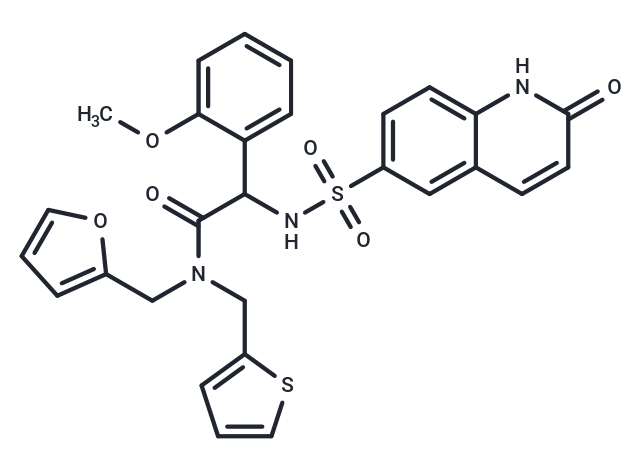Shopping Cart
Remove All Your shopping cart is currently empty
Your shopping cart is currently empty
OSMI-1 is an O-GlcNAc transferase (OGT) inhibitor (IC50=2.7 μM) that is orally active and cell-permeable. OSMI-1 inhibits protein O-GlcNA acetylation without qualitatively altering cell-surface N- or O- linked glycans.

| Pack Size | Price | USA Warehouse | Global Warehouse | Quantity |
|---|---|---|---|---|
| 1 mg | $35 | In Stock | In Stock | |
| 2 mg | $48 | In Stock | In Stock | |
| 5 mg | $80 | In Stock | In Stock | |
| 10 mg | $135 | In Stock | - | |
| 25 mg | $226 | In Stock | - | |
| 50 mg | $409 | In Stock | - | |
| 1 mL x 10 mM (in DMSO) | $88 | In Stock | In Stock |
| Description | OSMI-1 is an O-GlcNAc transferase (OGT) inhibitor (IC50=2.7 μM) that is orally active and cell-permeable. OSMI-1 inhibits protein O-GlcNA acetylation without qualitatively altering cell-surface N- or O- linked glycans. |
| Targets&IC50 | OGT:2.7 μM, CHO cells:50 μM |
| In vitro | METHODS: COS7 and Hela cells were treated with OSMI-1 (2-100 µM) for 24 h. Cell viability was measured using the CCK8 Assay. RESULTS: 50 µM OSMI-1 reduced cell viability by more than 50%. [1] METHODS: CHO cells were treated with OSMI-1 (10-100 µM) for 24 h, and the expression levels of target proteins were detected by Western Blot. RESULTS: OSMI-1 reduced global OGlcNAcylation in a dose-dependent manner, with a maximum effect at 50 µM. [2] |
| In vivo | METHODS: To assay antitumor activity in vivo, OSMI-1 (1 mg/kg, i.v.) and TRAIL (500 µg/kg, intraperitoneally) were administered to BALB/c-Foxn1nu/ArcGem nude mice harboring human colorectal carcinoma tumor HCT116 once daily for three weeks. RESULTS: Tumor size was slightly reduced in mice treated with OSMI-1 or TRAIL alone, but significantly reduced in the OSMI-1 and TRAIL combination group. The combination treatment synergistically increased the antitumor activity of transplanted tumors in HCT116 nude mice. [3] METHODS: To investigate the protective effect against Stx-mediated pathogenic responses, OSMI-1 (300-1000 µg/mouse in water containing 4.5% DMSO and 5% Tween 80) was injected intraperitoneally into Stx2a-attacked C57BL/6 mice once daily for seven days. RESULTS: O-GlcNAc inhibition ameliorated the mortality and various disease symptoms induced by Stx2a exposure in mice, which was further enhanced by O-GlcNAc inhibition. [4] |
| Molecular Weight | 563.64 |
| Formula | C28H25N3O6S2 |
| Cas No. | 1681056-61-0 |
| Smiles | COc1ccccc1C(NS(=O)(=O)c1ccc2[nH]c(=O)ccc2c1)C(=O)N(Cc1ccco1)Cc1cccs1 |
| Relative Density. | 1.389 g/cm3 (Predicted) |
| Storage | Powder: -20°C for 3 years | In solvent: -80°C for 1 year | Shipping with blue ice/Shipping at ambient temperature. | |||||||||||||||||||||||||||||||||||
| Solubility Information | DMSO: 104 mg/mL (184.51 mM), Sonication is recommended. | |||||||||||||||||||||||||||||||||||
| In Vivo Formulation | 10% DMSO+40% PEG300+5% Tween 80+45% Saline: 1.83 mg/mL (3.25 mM), Solution. Please add the solvents sequentially, clarifying the solution as much as possible before adding the next one. Dissolve by heating and/or sonication if necessary. Working solution is recommended to be prepared and used immediately. The formulation provided above is for reference purposes only. In vivo formulations may vary and should be modified based on specific experimental conditions. | |||||||||||||||||||||||||||||||||||
Solution Preparation Table | ||||||||||||||||||||||||||||||||||||
DMSO
| ||||||||||||||||||||||||||||||||||||
| Size | Quantity | Unit Price | Amount | Operation |
|---|

Copyright © 2015-2026 TargetMol Chemicals Inc. All Rights Reserved.